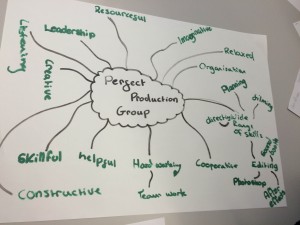Now that we have finished the dummy music video mash-up I’m evaluating the video so that I know where I can improve for my final music video.
What lessons did you learn about planning and the use of Storyboards/Shot Lists and Production Meeting Agendas? Why are they important when out on shoot?
They help us to keep organised and to be prepared when out filming. The production meeting agenda will make sure that we have all the props and costumes we need with us when filming, it will also improve our organisation to have the filming locations listed out. The shot list helped us to stick to the blueprint of the genre through the repertoire of elements in keeping with the contract with the audience. We didn’t make a storyboard it would have helped to have this as it would have made sure we got all the shots we needed
Plus TARGET: Create a storyboard planning out the shots I need so as to be more organised. I will also make sure that we plan what we need to film and where and the order of where we will film when so as the filming is as productive as possible.
What should the camera operator be doing whilst filming?
Since the actors move around quite a lot during the filming of music videos, it’s important to watch so that they stay in the frame. We made sure to film the whole song at lots of different angles and distances, this made sure that when editing we had enough shots to make the video. For this we made sure to watch the screen on the camera to make sure it looks right.
Plus TARGET: Focus more on the view from the camera to make sure nothing is cut out of the shot.
What lessons did you learn about directing people in front of the camera? What information do they need to know about their character / their performance style? How can the director get them to relax and have confidence in front of the camera in order to perform well?
One of the most important things we found was making sure that the actor felt comfortable enough to perform properly with confidence. To do this first we made sure that we had the music playing so they were confident of the lyrics and so they could get into the music. The performer(s) should know the style of the music so that they perform in the right style and are confident in what they have to do, to help with this you should also make sure that they are comfortable in what they have to do.
Plus TARGET: Bring the music for the actors the mime along to. Encourage the actors to go for it and make sure they are comfortable and confident.
What lessons did you learn about filming the performance for your production?
It makes the editing easier if you film a continuous shot of the whole song sung in all the various locations etc so you can cut to any other shot if needed at any time and have multiple options. It is important to film at multiple angles and distances (especially close ups). I also learnt that you have to be careful filming outside due to weather and quick changes in lighting etc.
Plus TARGET: Film the whole song for every angle and distance.
What did you learn about editing and post-production?
I learnt how to edit in time with the music beats. I also learnt how and when to cut between particular shots so as to highlight the star image and to keep with the genre of the music. The pace of the edit should reflect the pace of the music and therefore uphold the contract with the audience. It’s important to keep the edit interesting and often cut between different shot angles and distances to keep the music video interesting.
Plus TARGET: I will listen to the music whilst editing and cut with the beats of the song to make it more natural, I will also make the edit less complicated so as to be able to focus more on the star image.
What did you discover about the use of conventional Mise-En-Scene for music videos?
The mise-en-scene in music videos is usually conventional to the genre or to the band. For example we decided to have our main actor in a suit to reflect Justin Timberlakes style however we had him wearing brightly coloured ties in order to keep with the upbeat feel of the song and genre. Our acting was enthusiastic and upbeat also to keep with the generic blueprint. For the settings the sunny weather meant that filming outside reflected the song most so our locations are as bright and colourful as possible. From this I learnt that the location should reflect the emotions in the song.
Plus TARGET: Choose interesting eyecatching mise-en-scene that doesn’t take focus away from the star image. I will also choose practical yet interesting locations for filming in.



